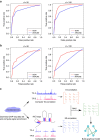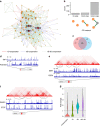Systematic identification of protein combinations mediating chromatin looping
- PMID: 27461729
- PMCID: PMC4974460
- DOI: 10.1038/ncomms12249
Systematic identification of protein combinations mediating chromatin looping
Abstract
Chromatin looping plays a pivotal role in gene expression and other biological processes through bringing distal regulatory elements into spatial proximity. The formation of chromatin loops is mainly mediated by DNA-binding proteins (DBPs) that bind to the interacting sites and form complexes in three-dimensional (3D) space. Previously, identification of DBP cooperation has been limited to those binding to neighbouring regions in the proximal linear genome (1D cooperation). Here we present the first study that integrates protein ChIP-seq and Hi-C data to systematically identify both the 1D- and 3D-cooperation between DBPs. We develop a new network model that allows identification of cooperation between multiple DBPs and reveals cell-type-specific and -independent regulations. Using this framework, we retrieve many known and previously unknown 3D-cooperations between DBPs in chromosomal loops that may be a key factor in influencing the 3D organization of chromatin.
Figures




Similar articles
-
Static and Dynamic DNA Loops form AP-1-Bound Activation Hubs during Macrophage Development.Mol Cell. 2017 Sep 21;67(6):1037-1048.e6. doi: 10.1016/j.molcel.2017.08.006. Epub 2017 Sep 7. Mol Cell. 2017. PMID: 28890333 Free PMC article.
-
CTCF-mediated chromatin loops enclose inducible gene regulatory domains.BMC Genomics. 2016 Mar 22;17:252. doi: 10.1186/s12864-016-2516-6. BMC Genomics. 2016. PMID: 27004515 Free PMC article.
-
Hierarchical cooperation of transcription factors from integration analysis of DNA sequences, ChIP-Seq and ChIA-PET data.BMC Genomics. 2019 May 8;20(Suppl 3):296. doi: 10.1186/s12864-019-5535-2. BMC Genomics. 2019. PMID: 32039697 Free PMC article.
-
Linking Chromatin Fibers to Gene Folding by Hierarchical Looping.Biophys J. 2017 Feb 7;112(3):434-445. doi: 10.1016/j.bpj.2017.01.003. Epub 2017 Jan 31. Biophys J. 2017. PMID: 28153411 Free PMC article. Review.
-
Making contacts on a nucleic acid polymer.Trends Biochem Sci. 2001 Dec;26(12):733-40. doi: 10.1016/s0968-0004(01)01978-8. Trends Biochem Sci. 2001. PMID: 11738597 Review.
Cited by
-
Genome-Wide Analysis of Circular RNAs Mediated ceRNA Regulation in Porcine Embryonic Muscle Development.Front Cell Dev Biol. 2019 Nov 19;7:289. doi: 10.3389/fcell.2019.00289. eCollection 2019. Front Cell Dev Biol. 2019. PMID: 31803743 Free PMC article.
-
Predict long-range enhancer regulation based on protein-protein interactions between transcription factors.Nucleic Acids Res. 2021 Oct 11;49(18):10347-10368. doi: 10.1093/nar/gkab841. Nucleic Acids Res. 2021. PMID: 34570239 Free PMC article.
-
A computational framework for identifying the transcription factors involved in enhancer-promoter loop formation.Mol Ther Nucleic Acids. 2020 Nov 17;23:347-354. doi: 10.1016/j.omtn.2020.11.011. eCollection 2021 Mar 5. Mol Ther Nucleic Acids. 2020. PMID: 33425492 Free PMC article.
-
A systematic study of motif pairs that may facilitate enhancer-promoter interactions.J Integr Bioinform. 2022 Feb 7;19(1):20210038. doi: 10.1515/jib-2021-0038. J Integr Bioinform. 2022. PMID: 35130376 Free PMC article.
-
MIR retrotransposons link the epigenome and the transcriptome of coding genes in acute myeloid leukemia.Nat Commun. 2022 Oct 31;13(1):6524. doi: 10.1038/s41467-022-34211-x. Nat Commun. 2022. PMID: 36316347 Free PMC article.
References
-
- Schleif R. DNA looping. Annu. Rev. Biochem. 61, 199–223 (1992). - PubMed
-
- Cremer T. & Cremer C. Chromosome territories, nuclear architecture and gene regulation in mammalian cells. Nat. Rev. Genet. 2, 292–301 (2001). - PubMed
-
- Fraser P. & Bickmore W. Nuclear organization of the genome and the potential for gene regulation. Nature 447, 413–417 (2007). - PubMed
Publication types
MeSH terms
Substances
Grants and funding
LinkOut - more resources
Full Text Sources
Other Literature Sources

